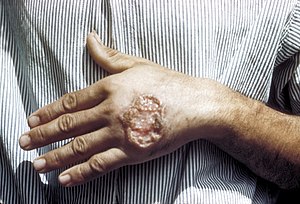Leishmaniasis
| Leishmaniasis | |
|---|---|
 |
|
| Cutaneous leishmaniasis in the hand of a Central American adult | |
| Pronunciation |
|
| Classification and external resources | |
| Specialty | Infectious disease |
| ICD-10 | B55 |
| ICD-9-CM | 085 |
| DiseasesDB | 3266 29171 |
| MedlinePlus | 001386 |
| eMedicine | emerg/296 |
| Patient UK | Leishmaniasis |
| MeSH | D007896 |
Leishmaniasis, also spelled leishmaniosis, is a disease caused by protozoan parasites of the genus Leishmania and spread by the bite of certain types of sandflies. The disease can present in three main ways: cutaneous, mucocutaneous, or visceral leishmaniasis. The cutaneous form presents with skin ulcers, while the mucocutaneous form presents with ulcers of the skin, mouth, and nose, and the visceral form starts with skin ulcers and then later presents with fever, low red blood cells, and enlarged spleen and liver.
Infections in humans are caused by more than 20 species of Leishmania. Risk factors include poverty, malnutrition, deforestation, and urbanization. All three types can be diagnosed by seeing the parasites under the microscope. Additionally, visceral disease can be diagnosed by blood tests.
Leishmaniasis can be partly prevented by sleeping under nets treated with insecticide. Other measures include spraying insecticides to kill sandflies and treating people with the disease early to prevent further spread. The treatment needed is determined by where the disease is acquired, the species of Leishmania, and the type of infection. Some possible medications used for visceral disease include liposomal amphotericin B, a combination of pentavalent antimonials and paromomycin, and miltefosine. For cutaneous disease, paromomycin, fluconazole, or pentamidine may be effective.
About 12 million people are currently infected in some 98 countries. About 2 million new cases and between 20 and 50 thousand deaths occur each year. About 200 million people in Asia, Africa, South and Central America, and southern Europe live in areas where the disease is common. The World Health Organization has obtained discounts on some medications to treat the disease. The disease may occur in a number of other animals, including dogs and rodents.
...
Wikipedia
